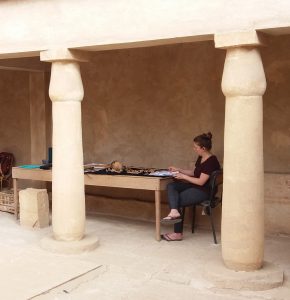It’s our third week in Egypt, the second in which we are actually excavating. Miriam is carefully clearing the hill north to our two small Ramesside chapels, in an area that we call the Coptic occupation layer (Fig. 1), i.e. not actually a house, but the remains of some occupation. Particularly interesting was the find of the dump of some workshop materials among which two flint stone knifes, a whetstone and a polishing stone. Underneath the first limestone walls showed. This means we are on our way to Ramesside age. In the meantime, the Milano 3D Survey group has finalized the scan of the tomb of Maya (Fig. 3) and is now continuing with the tomb of Tia and Tia. The results are amazing. Read more about their work next week!
Two scholars from Leiden University joined the team!
Miriam and Sarah have successfully started working at Saqqara. They are specialists on human bones and Egyptian archaeology and material culture. Sarah and Miriam were very happy to accept the invitation by the Leiden-Turin mission to look for a potential cooperation between the museums and the university with the possibility to bring bachelor and master students to Egypt to study the archaeology and material culture of ancient Egypt at such an exciting place! In her role as new assistant professor at the Faculty of Archaeology at Leiden University, Sarah specializes in the analysis of ancient human bones. For the Saqqara excavations she has now started analyzing the bones that were excavated last season (Fig. 2). So far, she has studied several child burials. There are no obvious diseases present on the bones of these children, which may suggest that they died suddenly. Sarah also found evidence for mummification – a plug in the ear of a skull, which appears to be very intentionally placed. Linen was often placed in the ears of the deceased so that evil spirits would not enter the body. Sarah has a lovely workspace in the tomb of Horemheb, where the skeletal material is conveniently stored.

Miriam Müller is carefully clearing the hill north to our two small Ramesside chapels.

Sarah Schrader in her workspace in the tomb of Horemheb: analyzing human bones excavated last season.

The Milano 3D Survey group has finalized the scan of the tomb of Maya.
Miriam has joined the excavations in her capacity as recently appointed lecturer in Egyptian archaeology, art and material culture at Leiden University. She specializes in household archaeology and the contextualization of finds within their archaeological contexts in order to study behavioral patterns, use and re-appropriation of ancient landscapes the Milano 3D Survey group has finalized the scan of the tomb of Maya a new approach that has also been implemented in the new research agenda of the Saqqara excavations, generously funded by a VIDI grant under the direction of Lara Weiss. Miriam has started documenting an area north of the tomb of Maya, which had yielded dense occupation layers in the previous season. A detailed stratigraphy from the Ramesside use of the area presents itself, in the form of burials with chapels and associated shafts, to the leveling and repurposing of this landscape by probably a Coptic community. The excavations of these layers will hopefully shed more light on the nature of the occupation and use in later periods of this area that was highly significant at the end of the 18th and beginning of the 19th dynasty
